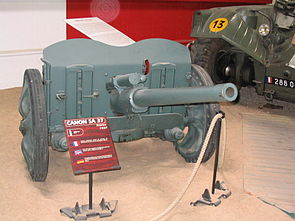Canon antichar de 47 mm modèle 1937
| Canon antichar de 47 mm modèle 1937 | |
|---|---|
|
|
|
| General Information | |
| Military designation: | Canon antichar de 47 mm modèle 1937 |
| Manufacturer country: | France |
| Developer / Manufacturer: | Atelier de Puteaux |
| Development year: | 1936 |
| Production time: | January 1939 to June 1940 |
| Number of pieces: | 1268 |
| Weapon Category: | Anti-tank gun |
| Team: | 5 soldiers |
| Technical specifications | |
| Overall length: | 3.95 m |
| Caliber : |
47 mm |
| Cadence : | 15-20 rounds / min |
| Elevation range: | −13 ° to + 16 ° angular degrees |
| Side straightening area: | 68 ° |
| Furnishing | |
| Ammunition supply: | Manually |
The Canon antichar de 47 mm modèle 1937 was a French- made anti-tank gun that was used in World War II .
development
The anti-tank gun originated from the "Canon de 47 mm de marine modèle 1885" designed by Hotchkiss et Cie , which after modernization became the "Canon de 47 mm AC modèle 1934" of the infantry. After it was abandoned by the infantry in favor of the more mobile canon antichar de 25 mm Hotchkiss, the artillery took it over and improved it from December 1936 to the "matériel de 47 modèle 1937" .
Their high quality in ballistics and penetration power made them one of the most powerful cannons of their time. She could destroy all tanks used at that time.
The high muzzle velocity caused high wear and tear on the cannon barrel . A change was introduced in 1938 that made it easier to replace the tube.
One variant was the Canon de 47 mm AC modèle 1934 ; it was only used in the bunkers of the Maginot Line .
ammunition
The armor-piercing ammunition "Projectile de 47 mm perforant (47X380R) modèle 1936" had a weight of 1.726 kg per shell and a muzzle velocity of 855 m / s. The penetration through armor steel was at an impact angle of 0 °:
- 106 mm at a distance of 100 meters
- 89 mm at a distance of 500 meters
- 72 mm at a distance of 1000 meters
- 57 mm at a distance of 1500 meters
The maximum firing range was 6500 meters.
Later tests carried out by the Wehrmacht showed a penetration through armor steel at an impact angle of 30 °:
- 57 mm at a distance of 100 meters
- 50 mm at a distance of 500 meters
- 42 mm at a distance of 1000 meters
- 36 mm at a distance of 1500 meters
The performance of the cannon was thus close to that of the 5 cm PaK 38 .
Production and use
The cannon barrels were manufactured by the Arsenal de Bourges, the mounts at Salmson , the Arsenal de Roanne, Delaunay-Belleville and Alstom . Series production began in January 1939 and ended in June 1940 . A total of 1268 guns were produced and 159 batteries were equipped.
For the gun and ammunition wagons, horse-drawn vehicles were mainly used. The cannon was driven in four horses, like the 75 mm field cannon . As circumstances allowed, the batteries were mechanized and equipped with the Citroën-Kégresse P17 E light tractors . The Laffly W 15 T truck was used as a towing vehicle for 75 batteries . Another 70 guns were built into the "Laffly W 15 T" armored vehicles. These belonged to the motorized anti-tank batteries.
Overall, the German army took over 823 PaK 181 (f) and incorporated them into tank destroyer companies of the infantry regiments.
An unknown number of these cannons were mounted on the Lorraine 37L crawler tractor . The vehicle had the designation "Panzerjäger-BehelfsSFL 4.7 cm Pak 181 (f)" or 183 (f).
Further technical information
- Manufacturer designation: 47 mm APX
- Total height: 1.21 m
- Weight in firing position: 1050 kg
- Weight in driving position: 1090 kg
- Pipe length: 2.35 m
- Caliber length: L / 53
- Effective combat distance: 1000 m
- Maximum firing range: 6500 m
- Case wedge lock
variants
47 mm SA 39 TAZ - a variant on a tripod mount with 360 ° horizontal swivel range; it was only produced as a prototype.
Literature and Sources
- Stéphane Ferrard: France 1940 l'armement terrestre. ETAI, 1998, ISBN 2-7268-8380-X
- Terry Gander, Peter Chamberlain: Encyclopedia of German Weapons 1939-1945. Motorbuchverlag, 2005, ISBN 3-613-02481-0
- Wolfgang Fleischer, Richard Eiermann: The German tank destroyer force 1935–1945. Podzun-Pallas Verlag, 1998, ISBN 3-7909-0613-1
- Un tueur sur la brèche, le matériel de 47 antichar modèle 1937. in the magazine Histoire de Guerre, blindés & matériel (N ° 82)
Web links
Footnotes
- ↑ In-house designation of the developer Atelier de Puteaux: 47 mm APX
- ↑ In GBM n ° 82, page 8.
- ↑ In GBM n ° 82, page 9.
- ↑ Wolfgang Fleischer, Richard Eiermann, p. 54
